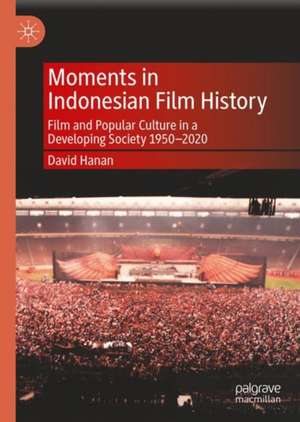Moments in Indonesian Film History: Film and Popular Culture in a Developing Society 1950–2020
Autor David Hananen Limba Engleză Hardback – 13 dec 2021
| Toate formatele și edițiile | Preț | Express |
|---|---|---|
| Paperback (1) | 727.80 lei 6-8 săpt. | |
| Springer International Publishing – 14 dec 2022 | 727.80 lei 6-8 săpt. | |
| Hardback (1) | 733.03 lei 6-8 săpt. | |
| Springer International Publishing – 13 dec 2021 | 733.03 lei 6-8 săpt. |
Preț: 733.03 lei
Preț vechi: 893.93 lei
-18% Nou
Puncte Express: 1100
Preț estimativ în valută:
140.27€ • 152.98$ • 118.27£
140.27€ • 152.98$ • 118.27£
Carte tipărită la comandă
Livrare economică 24 aprilie-08 mai
Preluare comenzi: 021 569.72.76
Specificații
ISBN-13: 9783030726126
ISBN-10: 3030726126
Pagini: 465
Ilustrații: XXI, 354 p. 34 illus., 26 illus. in color.
Dimensiuni: 148 x 210 x 29 mm
Greutate: 0.6 kg
Ediția:1st ed. 2021
Editura: Springer International Publishing
Colecția Palgrave Macmillan
Locul publicării:Cham, Switzerland
ISBN-10: 3030726126
Pagini: 465
Ilustrații: XXI, 354 p. 34 illus., 26 illus. in color.
Dimensiuni: 148 x 210 x 29 mm
Greutate: 0.6 kg
Ediția:1st ed. 2021
Editura: Springer International Publishing
Colecția Palgrave Macmillan
Locul publicării:Cham, Switzerland
Cuprins
Introduction.- Chapter 1. Filming the ‘Struggle for the Nation’, and its Aftermath: The Early Films of Usmar Ismail and the Perfini Company (1950-1954).- Chapter 2. A Tradition of Political Allegory and Political Satire in Indonesian Cinema (1955–2003).- Chapter 3. Islam in The Indonesian Cinema: Legends and Spirituality. Psychology and Politics (1960s–1990s).- Chapter 4. Betawi Moderen: Songs and Films of Benyamin S from Jakarta in the 1970s: A Popular Culture of the Poor.- Chapter 5. Third World Experimental Narrative in Indonesian Film: Travelling the Centre-Periphery Axis (1979-1985).- Chapter 6. Developments in Indonesian.- Cinema since 1998: A Survey.- Conclusion.
Notă biografică
David Hanan is the author of Cultural Specificity in Indonesian Film: Diversity in Unity (Palgrave Macmillan, 2017). He has researched film in Indonesia and South East Asia for more than thirty years. He is currently an Honorary Fellow in the Asia Institute at the University of Melbourne, Australia.
Textul de pe ultima copertă
‘Political allegory and satire, representations of Islam, third world cinema, films by newly-emerging women filmmakers—David Hanan’s panorama of exceptional moments in Indonesian cinema since independence shows expertise in the inspirational wealth of insights that he offers, in relating key films to the histories, national ideologies, and complex, evolving social formations from which these films emerge, and at times critique, in multicultural Indonesia.’
- Dina Iordanova, Emeritus Professor of Global Cinema at the University of St Andrews, Scotland
This book explores Indonesian cinema, focusing on moments of unique creativity by Indonesian film artists who illuminate important but less-widely-known aspects of their multi-dimensional society. It begins by exploring early 1950s ‘Indonesian neorealist films’ of the Perfini group, which depict the ethos and emerging moral issues of the period of struggle for independence (1945–49). It continues by discussing four audacious political allegories produced in four discrete political eras—including the Sukarno, Suharto and Reformasi periods. It also surveys the main approaches to Islam in both popular cinema and auteur films during the Suharto New Order. One chapter celebrates the popular songs and B-movies of the Betawi comedian, Benyamin S, which dramatize the experience of the poor in ‘modernizing’ Jakarta. Another examines persisting Third World dimensions of Indonesian society as critiqued in two experimental features. The concluding chapter highlights innovation in a renewed Indonesian cinema of the post-Suharto Reformasi period (1999–2020), including films by an unprecedented generation of women writer-directors
- Dina Iordanova, Emeritus Professor of Global Cinema at the University of St Andrews, Scotland
This book explores Indonesian cinema, focusing on moments of unique creativity by Indonesian film artists who illuminate important but less-widely-known aspects of their multi-dimensional society. It begins by exploring early 1950s ‘Indonesian neorealist films’ of the Perfini group, which depict the ethos and emerging moral issues of the period of struggle for independence (1945–49). It continues by discussing four audacious political allegories produced in four discrete political eras—including the Sukarno, Suharto and Reformasi periods. It also surveys the main approaches to Islam in both popular cinema and auteur films during the Suharto New Order. One chapter celebrates the popular songs and B-movies of the Betawi comedian, Benyamin S, which dramatize the experience of the poor in ‘modernizing’ Jakarta. Another examines persisting Third World dimensions of Indonesian society as critiqued in two experimental features. The concluding chapter highlights innovation in a renewed Indonesian cinema of the post-Suharto Reformasi period (1999–2020), including films by an unprecedented generation of women writer-directors
Caracteristici
Explores Indonesian film in three major political eras: the Sukarno, Suharto and the post-Suharto Reform periods One of the few books written on Indonesian cinema by a Film Studies specialist with a broad knowledge of world cinema Explores Indonesian film classics, auteur films, innovative political documentaries, and key moments in popular cinema
